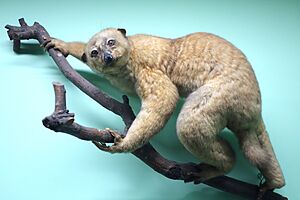Central African potto facts for kids
Quick facts for kids Central African potto |
|
|---|---|
 |
|
| Specimen at the Royal Museum for Central Africa | |
| Conservation status | |
| Scientific classification | |
| Synonyms | |
|
The Central African potto (Perodicticus edwardsi) is a small, furry animal that lives in trees. It is a type of primate, like monkeys and apes, but it is active mostly at night. This potto is found in the forests of Central Africa. It is also sometimes called Milne-Edwards's potto, named after a scientist named Alphonse Milne-Edwards.
Contents
About the Central African Potto
How Scientists Classify Them
For a long time, scientists thought the Central African potto was just a type of another potto, the West African potto. But in 2015, a new study looked closely at pottos. This study showed that the Central African potto is actually its own special species.
Scientists believe the Central African potto is closely related to the East African potto. They think these two types of pottos became separate species a very long time ago. This happened about 5.5 million years ago.
There was also a mystery about something called the "false potto". Some scientists thought it might be a different animal. However, many now believe the "false potto" was just a Central African potto that was misidentified.
Where Do They Live?
The Central African potto lives in a wide area of Africa. You can find them from Nigeria in the west, all the way to the Central African Republic and the Democratic Republic of the Congo in the east. They also live south into Angola. The large Niger River acts like a natural border. It separates the Central African potto from the West African potto.
Keeping Pottos Safe
The Central African potto is currently listed as a species of "Least Concern" by the IUCN Red List. This means they are not in immediate danger of disappearing. These pottos are very good at adapting to different places. They can live in untouched forests and even in areas where people have changed the land. You might even find them living close to human towns.
However, in some local areas, their numbers might be going down. This can happen because of deforestation, which is when forests are cut down for farming. They are also sometimes hunted for food. Scientists and conservation groups are working to make sure these unique animals stay safe in their homes.


